Consumer Travel Behaviors and Transport Carbon Emissions: A Comparative Study of Commercial Centers in Shenyang, China
Abstract
:1. Introduction
2. Data and Methodology
2.1. Study Area
2.2. Data Collection
2.3. CO2 Emissions Model
3. Results
3.1. Characteristics of Shoppers
3.2. Transport CO2 Emissions
3.2.1. Commercial Centers with High CO2 Emissions: Wuai and Nanta
3.2.2. Commercial Centers with Medium CO2 Emissions: Hunnan, Middle Street and Taiyuan Street
3.2.3. Commercial Centers with Low CO2 Emissions: Xita-Beishi, Beihang and Tiexi
4. Discussion
4.1. Location and Transport Carbon Emissions
4.2. Retail Type and Energy Consumption
4.3. Sustainability of Travel Behavior
5. Conclusions
Acknowledgments
Author Contributions
Conflicts of Interest
References
- Ishii, S.; Tabushi, S.; Aramaki, T.; Hanaki, K. Impact of future urban form on the potential to reduce Greenhouse gas emissions from residential, commercial and public buildings in Utsunomiya, Japan. Energy Policy 2010, 38, 4888–4896. [Google Scholar] [CrossRef]
- Pearce, D. The role of carbon taxes in adjusting to global warming. Econ. J. 1991, 101, 938–948. [Google Scholar] [CrossRef]
- Banister, D. Cities, mobility and climate change. J. Transp. Geogr. 2011, 19, 1538–1546. [Google Scholar] [CrossRef]
- Alkhathlan, K.; Javid, M. Carbon emissions and oil consumption in Saudi Arabia. Renew. Sustain. Energy Rev. 2015, 48, 105–111. [Google Scholar] [CrossRef]
- Walmsley, M.R.W.; Walmsley, T.G.; Atkins, M.J.; Kamp, P.J.J.; Neale, J.R.; Chand, A. Carbon emissions pinch analysis for emissions reductions in the New Zealand transport sector through to 2050. Energy 2015, 92, 569–576. [Google Scholar] [CrossRef]
- Sim, L.L.; Malone-Lee, L.C.; Chin, K.H.L. Integrating land use and transport planning to reduce work-related travel: A case study of tampines regional centre in Singapore. Habitat Int. 2001, 25, 399–414. [Google Scholar] [CrossRef]
- Hankey, S.; Marshall, J.D. Impacts of urban form on future U.S. passenger-vehicle Greenhouse gas emissions. Energy Policy 2010, 38, 4880–4887. [Google Scholar] [CrossRef]
- Wang, S.; Fang, C.; Wang, Y.; Huang, Y.; Ma, H. Quantifying the relationship between urban development intensity and carbon dioxide emissions using a panel data analysis. Ecol. Ind. 2015, 49, 121–131. [Google Scholar] [CrossRef]
- Yang, W.; Li, T.; Cao, X. Examining the impacts of socio-economic factors, urban form and transportation development on CO2 emissions from transportation in China: A panel data analysis of China’s provinces. Habitat Int. 2015, 49, 212–220. [Google Scholar] [CrossRef]
- Ye, H.; He, X.; Song, Y.; Li, X.; Zhang, G.; Lin, T.; Xiao, L. A sustainable urban form: The challenges of compactness from the viewpoint of energy consumption and carbon emission. Energ Build. 2015, 93, 90–98. [Google Scholar] [CrossRef]
- Ewing, R.; Cervero, R. Travel and the built environment: A meta-analysis. J. Am. Plan. Assoc. 2010, 76, 265–294. [Google Scholar] [CrossRef]
- Handy, S.; Cao, X.; Mokhtarian, P. Correlation or causality between the built environment and travel behavior? Evidence from Northern California. Transp. Res. Part D Transp. Environ. 2005, 10, 427–444. [Google Scholar] [CrossRef]
- Wegener, M. Overview of land-use transport models. Handb. Transp. Geogr. Spat. Syst. 2004, 5, 127–146. [Google Scholar]
- Anderson, W.P.; Kanaroglou, P.S.; Miller, E.J. Urban form, energy and the environment: A review of issues, evidence and policy. Urban Stud. 1996, 33, 7–35. [Google Scholar] [CrossRef]
- Echenique, M.H.; Hargreaves, A.J.; Mitchell, G.; Namdeo, A. Growing cities sustainably: Does urban form really matter? J. Am. Plan. Assoc. 2012, 78, 121–137. [Google Scholar] [CrossRef]
- Kitamura, R.; Akiyama, T.; Yamamoto, T.; Golob, T. Accessibility in a metropolis: Toward a better understanding of land use and travel. Transp. Res. Rec. J. Transp. Res. Board 2001, 64–75. [Google Scholar] [CrossRef]
- Lee, S.; Lee, B. The influence of urban form on GHG emissions in the U.S. household sector. Energy Policy 2014, 68, 534–549. [Google Scholar] [CrossRef]
- Cirilli, A.; Veneri, P. Spatial structure and carbon dioxide (CO2) emissions due to commuting: An analysis of Italian urban areas. Reg. Stud. 2014, 48, 1993–2005. [Google Scholar] [CrossRef]
- Scott, D.M.; Kanaroglou, P.S.; Anderson, W.P. Impacts of commuting efficiency on congestion and emissions: Case of the Hamilton CMA, Canada. Transp. Res. Part D Transp. Environ. 1997, 2, 245–257. [Google Scholar] [CrossRef]
- Chai, Y.; Zhang, Y.; Liu, Z. Spatial differences of home-work separation and the impacts of housing policy and urban sprawl: Evidence from household survey data in Beijing. Acta Geogr. Sin. 2011, 66, 157–166. [Google Scholar]
- Yeates, M.; Montgomery, D. The changing commercial structure of non-metropolitan urban centres and vacancy rates. Can. Geogr. 1999, 43, 382–399. [Google Scholar] [CrossRef]
- Cao, L.; Chai, Y. Daily shopping activity space of the elderly in Shanghai city. Hum. Geogr. 2006, 21, 50–54. [Google Scholar]
- Shi, Y.; Wu, J.; Wang, S. Spatio-temporal features and the dynamic mechanism of shopping center expansion in Shanghai. Appl. Geogr. 2015, 65, 93–108. [Google Scholar] [CrossRef]
- Sun, G.; Chen, Z. The retrospect and prospect on the commercial spatial researches in China and the corresponding compaer with western countries since the 1920’s. Hum. Geogr. 2008, 23, 78–83. [Google Scholar]
- Guan, C.; Cui, G. Progress in research on foreign commercial geography since the 1990’s. World Reg. Stud. 2003, 12, 44–53. [Google Scholar]
- Cachon, G.P. Retail store density and the cost of Greenhouse gas emissions. Manag. Sci. 2014, 60, 1907–1925. [Google Scholar] [CrossRef]
- Motoshita, M.; Sakagami, M.; Kudoh, Y.; Tahara, K.; Inaba, A. Potential impacts of information disclosure designed to motivate Japanese consumers to reduce carbon dioxide emissions on choice of shopping method for daily foods and drinks. J. Clean. Prod. 2015, 101, 205–214. [Google Scholar] [CrossRef]
- Wang, D.; Wang, C.; Xie, D.; Zhong, W.; Wu, M.; Zhu, W.; Zhou, J.; Li, Y. Comparison of retail trade areas of retail centers with different hierarchical levels: A case study of east nanjing road, wujioachang, anshan road in Shanghai. Urban Plan. Forum 2015, 3, 50–60. [Google Scholar]
- Li, J.; Zhang, P.; Lo, K.; Guo, M.; Wang, M. Reducing carbon emissions from shopping trips: Evidence from china. Energies 2015, 8, 10043–10057. [Google Scholar] [CrossRef]
- Ren, W.; Xue, B.; Geng, Y.; Lu, C.; Zhang, Y.; Zhang, L.; Fujita, T.; Hao, H. Inter-city passenger transport in larger urban agglomeration area: Emissions and health impacts. J. Clean. Prod. 2016, 114, 412–419. [Google Scholar] [CrossRef]
- Lin, T. Carbon dioxide emissions from transport in Taiwan’s national parks. Tour. Manag. 2010, 31, 285–290. [Google Scholar] [CrossRef]
- Dai, H.; Mischke, P.; Xie, X.; Xie, Y.; Masui, T. Closing the gap? Top-down versus bottom-up projections of China’s regional energy use and CO2 emissions. Appl. Energy 2016, 162, 1355–1373. [Google Scholar] [CrossRef]
- Selvakkumaran, S.; Limmeechokchai, B. Low carbon society scenario analysis of transport sector of an emerging economy—The aim/enduse modelling approach. Energy Policy 2015, 81, 199–214. [Google Scholar] [CrossRef]
- Wang, C.; Cai, W.; Lu, X.; Chen, J. CO2 mitigation scenarios in China’s road transport sector. Energy Convers. Manag. 2007, 48, 2110–2118. [Google Scholar] [CrossRef]
- Wang, Z.; Chen, F.; Fujiyama, T. Carbon emission from urban passenger transportation in Beijing. Transp. Res. Part D Transp. Environ. 2015, 41, 217–227. [Google Scholar] [CrossRef]
- Tichavska, M.; Tovar, B. Environmental cost and eco-efficiency from vessel emissions in Las Palmas Port. Transp. Res. Part E Logist. Transp. Rev. 2015, 83, 126–140. [Google Scholar] [CrossRef]
- Ma, J.; Heppenstall, A.; Harland, K.; Mitchell, G. Synthesising carbon emission for mega-cities: A static spatial microsimulation of transport CO2 from urban travel in Beijing. Comput. Environ. Urban Syst. 2014, 45, 78–88. [Google Scholar] [CrossRef]
- Howitt, O.J.; Revol, V.G.; Smith, I.J.; Rodger, C.J. Carbon emissions from international cruise ship passengers’ travel to and from New Zealand. Energy Policy 2010, 38, 2552–2560. [Google Scholar] [CrossRef]
- Zhang, Q.; Tao, X.; Yang, P. Research on carbon emissions from metropolis urban passenger transport and countermeasures. Chin. Popul. Resour. Environ. 2012, 22, 35–42. [Google Scholar]
- Chu, C.; Chen, H.; Chen, J. Empirical analysis and accounting of carbon emissions for urban road passenger transportation. Ecol. Econ. 2015, 31, 56–60. [Google Scholar]
- Liu, S.; Zhao, M.; Bao, C.; Liu, J. Carbon emission calculation for urban transport based on scenario analysis of traffic structure. J. Transp. Syst. Eng. Inf. Technol. 2015, 15, 222–227. [Google Scholar]
- Tong, K.; Ma, K. Significant impact of job-housing distance on carbon emissions from transport: A scenario analysis. Acta Ecol. Sin. 2012, 32, 2975–2984. [Google Scholar] [CrossRef]
- Xu, Z.; Zou, Z.; Cao, B. Carbon emission assessments of passenger transport in urban city and approaches to low carbon development-take Tianjin city as an example. J. Beijing Univ. Technol. 2013, 39, 1007–1013. [Google Scholar]
- Masucci, A.P.; Stanilov, K.; Batty, M. Limited urban growth: London’s street network dynamics since the 18th century. PLoS ONE 2013, 8. [Google Scholar] [CrossRef] [PubMed]
- Chen, J.; Yang, S.T.; Li, H.W.; Zhang, B.; Lv, J.R. Research on geographical environment unit division based on the method of natural breaks (jenks). ISPRS—Int. Arch. Photogramm. Remote Sens. Spat. Inf. Sci. 2013, XL-4/W3, 47–50. [Google Scholar] [CrossRef]
- Wang, F.; Meng, Y. Analyzing urban population change patterns in Shenyang, China 1982–90: Density function and spatial association approaches. Geogr. Inf. Sci. 1999, 5, 121–130. [Google Scholar] [CrossRef]
- Qin, Z.; Zhang, P. Simulation analysis on spatial pattern of urban population in Shenyang city, China in late 20th century. Chin. Geogr. Sci. 2011, 21. [Google Scholar] [CrossRef]
- Yu, B.; Yang, Z.; Cheng, C. Optimizing the distribution of shopping centers with parallel genetic algorithm. Eng. Appl. Artif. Intell. 2007, 20, 215–223. [Google Scholar] [CrossRef]
- Erkip, F.; Ozuduru, B.H. Retail development in Turkey: An account after two decades of shopping malls in the urban scene. Prog. Plan. 2015, 102, 1–33. [Google Scholar] [CrossRef]
- Carling, K.; Håkansson, J.; Jia, T. Out-of-town shopping and its induced CO2-emissions. J. Retail. Consum. Serv. 2013, 20, 382–388. [Google Scholar] [CrossRef]
- Stead, D. Relationships between land use, socioeconomic factors, and travel patterns in Britain. Environ. Plan. B 2001, 28, 499–528. [Google Scholar] [CrossRef]
- Jain, D.; Tiwari, G. How the present would have looked like? Impact of non-motorized transport and public transport infrastructure on travel behavior, energy consumption and CO2 emissions-Delhi, Pune and Patna. Sustain. Cities Soc. 2016, 22, 1–10. [Google Scholar] [CrossRef]
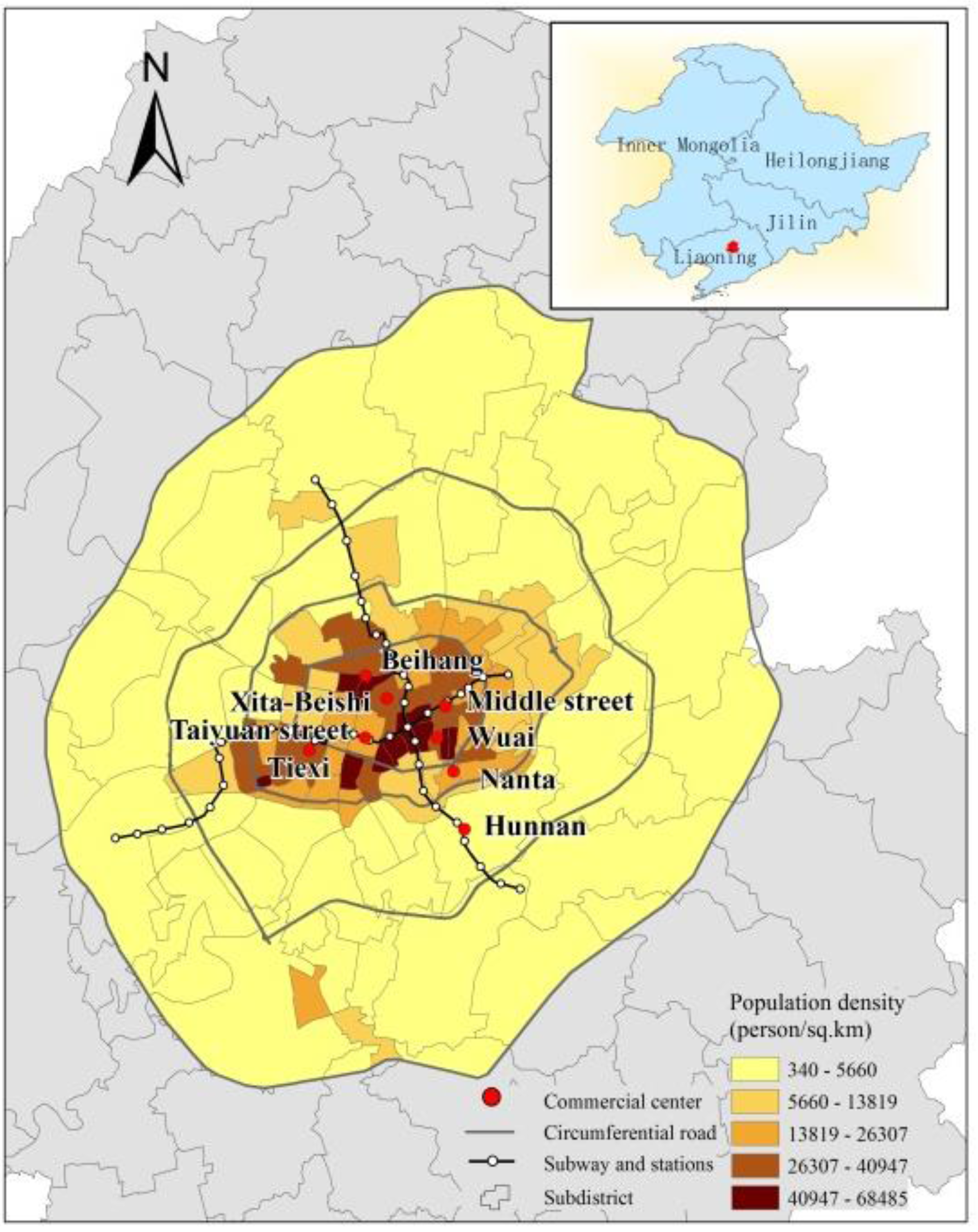
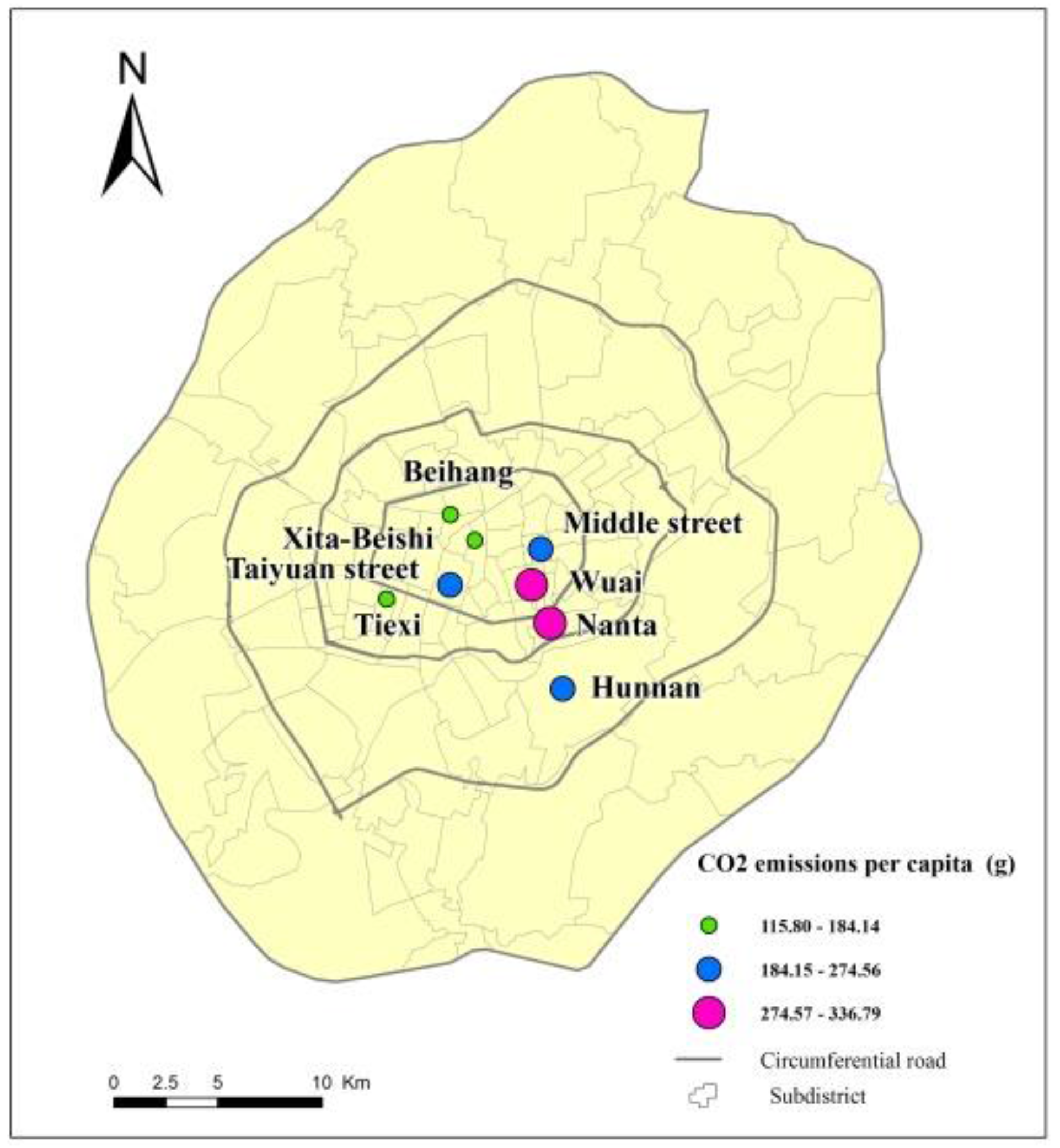
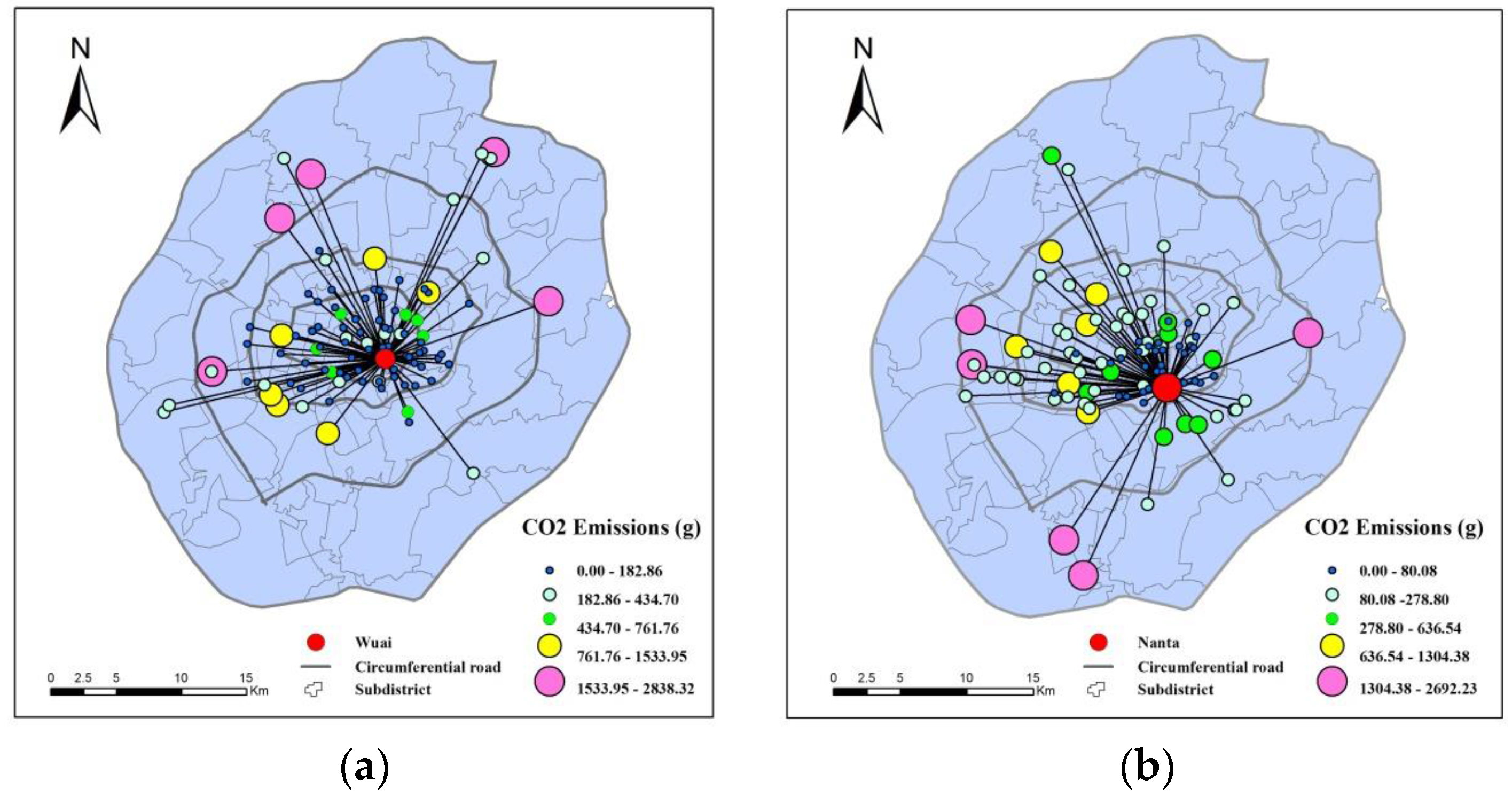
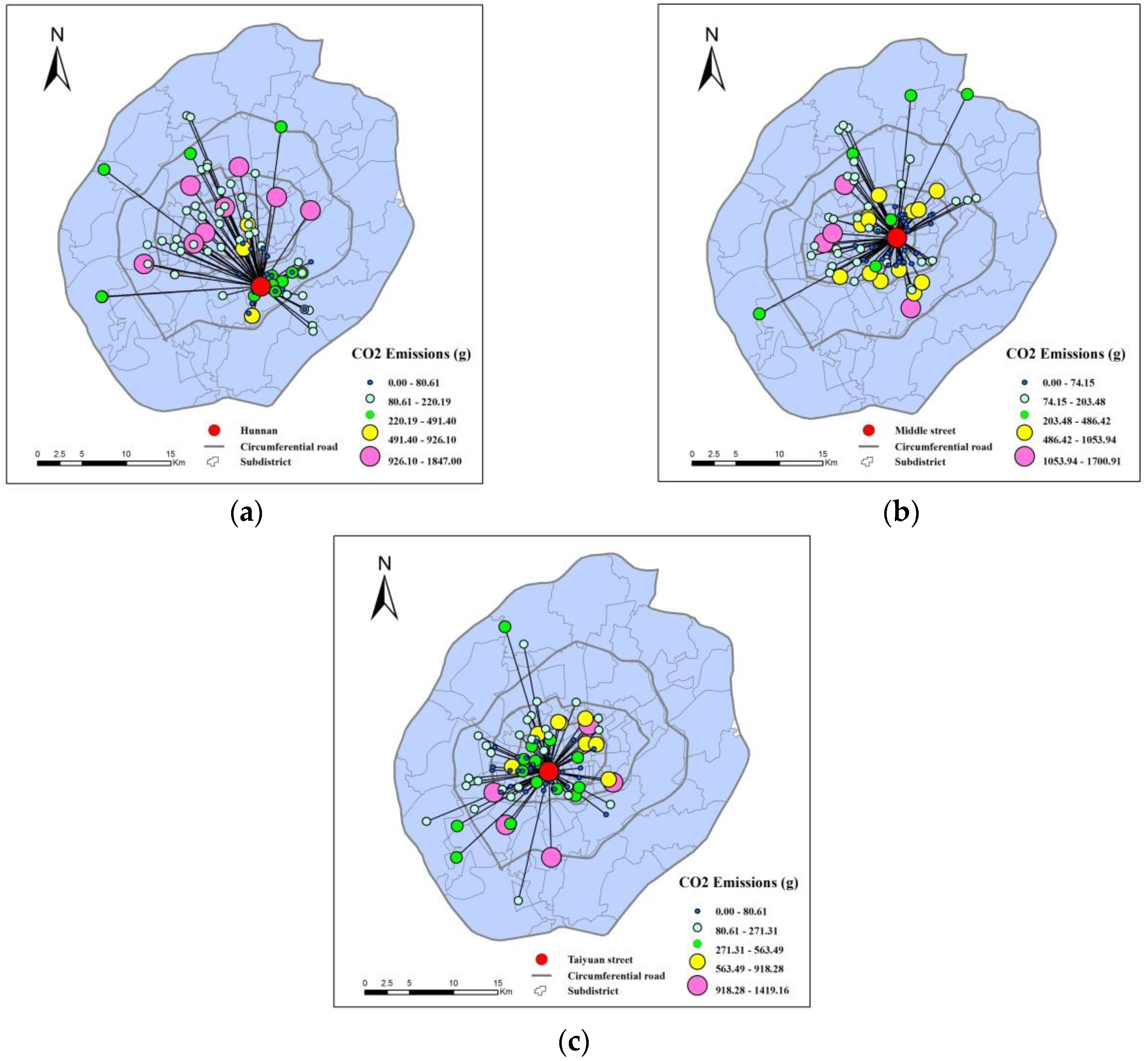
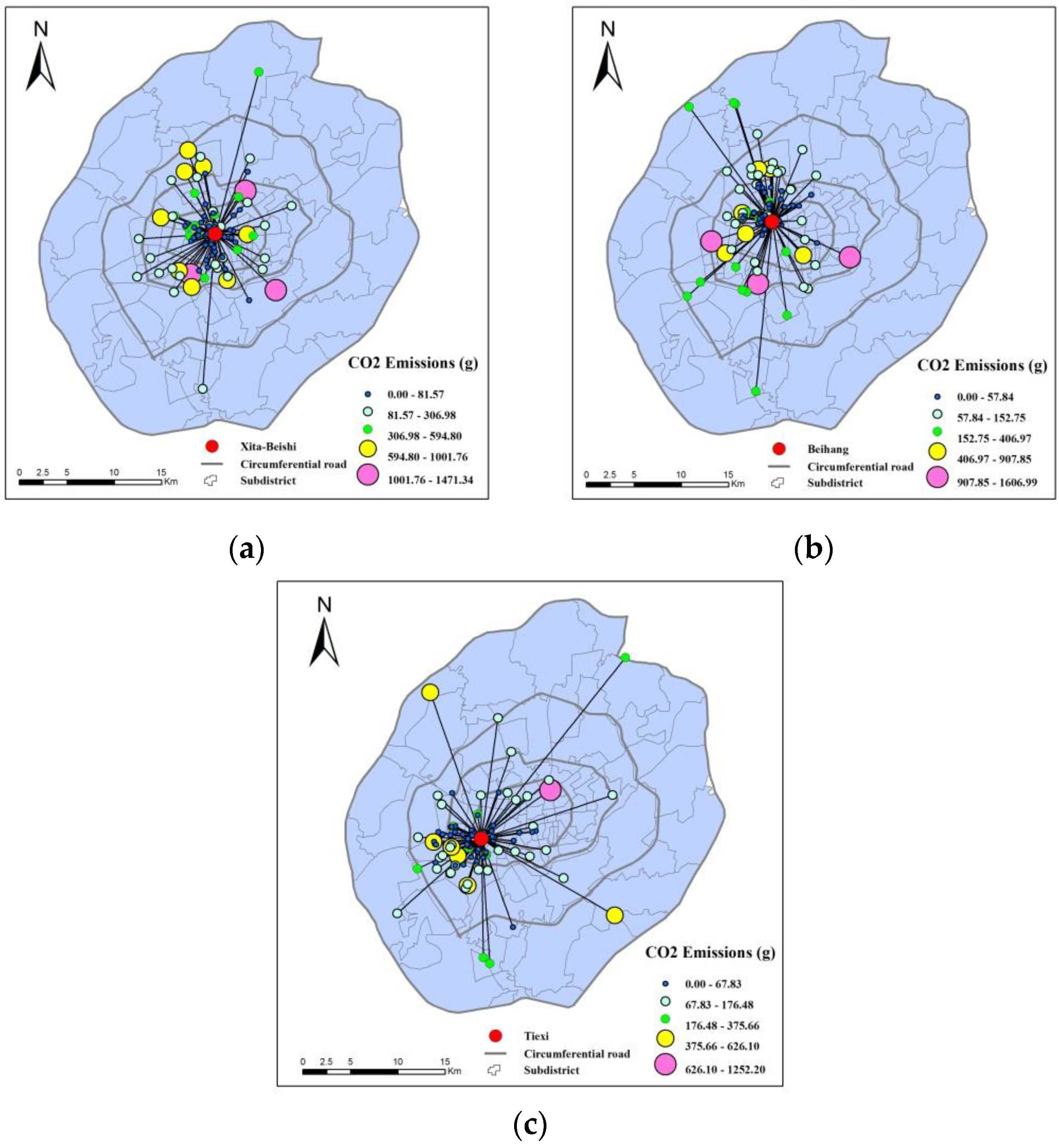
| Commercial Center | Location | Type | No. of Subway Lines | No. of Bus Routes |
|---|---|---|---|---|
| Middle Street | City center | Municipal | 1 | 68 |
| Taiyuan Street | City center | Municipal | 1 | 43 |
| Wuai | Inner city | Wholesale | 1 | 19 |
| Beihang | Inner city | Regional | 0 | 30 |
| Xita-Beishi | Inner city | Regional | 0 | 30 |
| Tiexi | Inner city | Regional | 0 | 19 |
| Nanta | Inner city | Wholesale | 1 | 17 |
| Hunnan | Suburban | Regional | 1 | 25 |
| Travel Mode | Average Fuel/Power Consumption Rate (F or C) | Fuel Density (ρ) | Emission Factor (EF) | Transport Capacity (AC) |
|---|---|---|---|---|
| Bus | 34.0 m3/100 km | - | 2.2 tCO2/1000 Nm3 | 49.5 |
| Subway | 454.0 kWh/100 km | - | 0.8 kg/kWh | 360.0 |
| Electric bike | 2.8 kWh/100 km | - | 0.8 kg/kWh | 1.2 |
| Taxi | 8.7 m3/100 km | - | 2.2 tCO2/1000 Nm3 | 2.0 |
| Private car | 10.5 L/100 km | 740.8 kg /m3 | 2.9 tCO2/t | 2.2 |
| Car Ownership (%) | Travel Mode (%) | Gender (%) | Age Group, Years (%) | Education Level (%) | Occupation (%) | Per Capita Monthly Income, CNY (%) |
|---|---|---|---|---|---|---|
| Yes (36.0); No (64.0) | Walking, Cycling (17.8); Bus (44.5); Subway (15.4); Electric bike (2.2); Taxi (4.4); Private car (15.7) | Male (40.1); Female (59.9) | ≤18 (2.8); 19–25 (26.7); 26–35 (35.0); 36–50 (19.7); 51–65 (12.7); >65 (3.1) | Below High school (22.3); High school (14.6); Undergraduate degree (57.8); Master’s degree or higher (5.3) | Public (23.3); Business (38.6); Self-employed (17.2); Unemployed (7.5); Retirement (13.4) | <2000 (16.6); 2000–3000 (27.8); 3000–5000 (33.9); >5000 (21.7) |
| Commercial Center | Level | Range (g) | Percentage (%) |
|---|---|---|---|
| Wuai | Very high | 1533.95–2838.32 | 4.59 |
| High | 761.76–1533.95 | 5.94 | |
| Medium | 434.70–761.76 | 7.92 | |
| Low | 182.86–434.70 | 16.83 | |
| Very low | 0.00–182.86 | 64.36 | |
| Nanta | Very high | 1304.38–2692.23 | 4.81 |
| High | 636.54–1304.38 | 5.77 | |
| Medium | 278.80–636.53 | 9.62 | |
| Low | 80.08–278.80 | 43.27 | |
| Very low | 0.00–80.08 | 36.54 | |
| Hunnan | Very high | 926.10–1847.00 | 7.48 |
| High | 491.40–926.10 | 4.67 | |
| Medium | 220.19–419.40 | 15.89 | |
| Low | 80.61–220.19 | 48.60 | |
| Very low | 0.00–80.61 | 23.36 | |
| Middle Street | Very high | 1053.94–1700.91 | 3.85 |
| High | 486.42–1053.94 | 13.46 | |
| Medium | 203.48–486.42 | 7.69 | |
| Low | 74.15–203.48 | 36.54 | |
| Very low | 0.00–74.15 | 38.46 | |
| Taiyuan Street | Very high | 918.28–1419.16 | 5.21 |
| High | 563.49–918.28 | 8.33 | |
| Medium | 271.31–563.49 | 15.63 | |
| Low | 80.61–271.31 | 32.29 | |
| Very low | 0.00–80.671 | 38.54 | |
| Xita-Beishi | Very high | 1001.76–1471.34 | 2.61 |
| High | 594.80–1001.76 | 6.96 | |
| Medium | 306.98–594.80 | 10.43 | |
| Low | 81.57–306.98 | 23.48 | |
| Very low | 0.00–81.57 | 56.52 | |
| Beihang | Very high | 907.85–1606.99 | 2.61 |
| High | 406.97–907.85 | 5.22 | |
| Medium | 152.75–406.97 | 13.04 | |
| Low | 57.84–152.75 | 26.09 | |
| Very low | 0.00–57.84 | 53.04 | |
| Tiexi | Very high | 626.10–1252.20 | 0.93 |
| High | 375.66–626.10 | 5.56 | |
| Medium | 176.48–375.66 | 10.19 | |
| Low | 67.83–176.48 | 30.56 | |
| Very low | 0.00–67.83 | 52.78 |
© 2016 by the authors; licensee MDPI, Basel, Switzerland. This article is an open access article distributed under the terms and conditions of the Creative Commons Attribution (CC-BY) license (http://creativecommons.org/licenses/by/4.0/).
Share and Cite
Li, J.; Lo, K.; Zhang, P.; Guo, M. Consumer Travel Behaviors and Transport Carbon Emissions: A Comparative Study of Commercial Centers in Shenyang, China. Energies 2016, 9, 765. https://doi.org/10.3390/en9100765
Li J, Lo K, Zhang P, Guo M. Consumer Travel Behaviors and Transport Carbon Emissions: A Comparative Study of Commercial Centers in Shenyang, China. Energies. 2016; 9(10):765. https://doi.org/10.3390/en9100765
Chicago/Turabian StyleLi, Jing, Kevin Lo, Pingyu Zhang, and Meng Guo. 2016. "Consumer Travel Behaviors and Transport Carbon Emissions: A Comparative Study of Commercial Centers in Shenyang, China" Energies 9, no. 10: 765. https://doi.org/10.3390/en9100765







